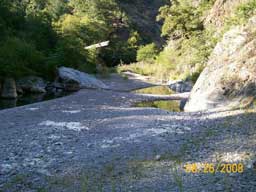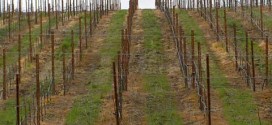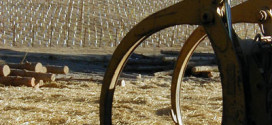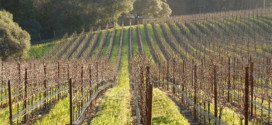Summertime Dewatering:
Slow but Sure Death to the River!
by Richard W. DeHaven
Fish and Wildlife Biologist (Retired)
– September 2008 –
An ugly phenomenon is revealing its head again this year on the Gualala River. As summer progressed, more and more main-stem, downstream reaches have developed intermittent surface flows characterized by a series of slowly drying pools, or worse – up to hundreds of linear feet of stream without any surface flow at all!
 Such dewatering is a relatively recent summertime phenomenon, having slowly appeared over the past 3-4 decades. And unfortunately, this year, before winter rains finally arrive and start to replenish the stream, dewatering will likely gradually worsen for at least several more weeks. Why has dewatering now become such a common component of the summertime landscape?
Such dewatering is a relatively recent summertime phenomenon, having slowly appeared over the past 3-4 decades. And unfortunately, this year, before winter rains finally arrive and start to replenish the stream, dewatering will likely gradually worsen for at least several more weeks. Why has dewatering now become such a common component of the summertime landscape?
Unfortunately, it directly reflects the overall poor health of certain parts of the watershed due to several factors, among the most important of which are:
- excessive sediment build-up at low-gradient areas, stream junctions and other locations;
- multiple perturbations from decades of gravel mining (i.e., in the vicinity of Wheatfield-South forks confluence); and
- main-stem, summertime surface-flow reductions, due to cumulative landscape changes and water diversions, both surface and subsurface, legal and illegal.
Many diversions occur at the worst possible time – the low-flow summer season, when juvenile steelhead (JSH) face major survival challenges in the form of elevated water temperatures and dramatically declining areal extent of aquatic habitat.
The harm associated with summertime water diversions is well-understood and documented. Nevertheless, new diversions continue to appear and existing ones are often increased without any authorization or consideration of their cumulative effects. For example, in early 2008, I discovered yet another new, unauthorized, unscreened surface-water diversion on the Wheatfield Fork, a few miles upstream of the Annapolis Road bridge. Its purpose: to water the grass of a playing field during summer! Unfortunately, I was unsuccessful in gaining the stakeholder’s cooperation in removing it to protect steelhead. Thus, National Marine Fisheries Service’s law enforcement division was brought in to deal with the matter (the issue of “take” of a Federally listed species).
Although this particular diversion was recently removed, dewatering at various locations downstream of the site during summer 2008, may have been exacerbated due to the several weeks in summer that it was operated. And, unfortunately, based on my earliest surveys (2001- 2002) in the watershed, this type of incremental, flow-reducing event is just the tip of the proverbial iceberg. Dozens of small increments such as this, involving diversion of either surface or subsurface flows (e.g., via pumping from wells) are in operation throughout the watershed. Their cumulative impacts to surface stream flows are both significant and large.
Nevertheless, why is dewatering so pervasive and severe in 2008, a year in which overall, about 83% of average seasonal rainfall occurred in the watershed? The answer is that a “tipping point” which now exists was exceeded, because of a record dry springtime. In particular, after a mid-season, 13-inch rainfall event which lasted 14 days and ended on February 3, 2008, only about 5 more inches of rain fell during the rest of the 2008 rainfall season. March and April were critically dry, with only about a half-inch of rainfall each month. With the river’s degraded condition, such a dry springtime, regardless of the overall seasonal rainfall total, today invariably results in low summertime flows, extensive dewatering and poor rearing conditions for JSH.
Dewatering adversely affects JSH rearing by raising water temperatures – often to lethal levels, reducing areal extent of habitat and eliminating the stream connectivity they require to escape to more hospitable (cooler) areas.
And the severe dewatering occurring in 2008 is especially disconcerting. This is because in winter and spring of 2008, I recorded the largest spawning return of adult steelhead on the Wheatfield Fork – an estimated 4,000-6,000 adult fish – in at least 8 years and most likely in several decades. This was followed, at the start of summer 2008, by the highest numbers and densities of JSH (10x average) I have to date recorded. Unfortunately, the encouraging early-season values for JSH plummeted dramatically over summer, as flows declined, water temperatures soared, and the inevitable dewatering intensified. In sum, what started as a record season for JSH – as well as for adult steelhead spawners – quickly became just another “average” season.
But the story is not complete without describing how the record spawning return of 2008 was itself inextricably linked to the dewatering issue. How? During the summers of both 2005 and 2006, NO (or very little) dewatering occurred and the stream had continuous, uninterrupted surface flows until the next rainy season began! Thus, summertime JSH rearing conditions were good and large numbers of JSH eventually migrated to sea in good condition (and large size). This was likely the reason for the record return of adult fish in 2008, 2-3 years later.
The lack of dewatering in 2005 and 2006 was the consequence of two unique gifts from Mother Nature. She dropped copious, well-above-average rainfall in the springtime of each of these years. Heavy springtime rainfall “charges” the watershed up just before the onset of summer. This in turn facilitates the continuous surface flows which persist until the start of the next rainy season, despite the river’s degraded state.
However, we clearly cannot depend, at least with any regularity, on heavy springtime rainfall to provide the good summertime rearing conditions that JSH require to produce large adult steelhead returns 2-3 years later. Based on decades of rainfall records, the probability of such copious rainfall in springtime is relatively low.
Preserving the remaining steelhead population and having reasonable expectations of restoring it to some level of its former glory, not to mention restoring the river’s presently, all-but-extinct coho salmon, necessitates effective management (i.e., halting, then reversing) of the dewatering phenomenon. Dewatering is an all-too-common thread in catastrophic losses of anadromous fisheries in streams across California. And we have our warning: Dewatering is the “slippery slope” that the Gualala River is already sliding down.
I am currently working with Wildlands, Inc., a company that specializes in creating fish and wildlife mitigation banks, and the Fishery Foundation of California, a certified non-profit entity whose mission is to improve fishery resources in the State of California. We are developing a new strategy for dealing with the river’s dewatering problem. We will soon be revealing this strategy and seeking cooperating stakeholders with which to implement it where feasible. To stay abreast of these developments and other issues related to Gualala River Steelhead Studies, visit my website at: www.gualalariversteelhead.info.
 Richard DeHaven will speak on the topic, Gualala River:
Richard DeHaven will speak on the topic, Gualala River:
On its Deathbed or Verge of a Miracle?
Saturday, October 18, 2008
Gualala Community Center
See also:
Upper reaches have water – and fish In Buckeye Creek, water is flowing continuously and steelhead are abundant – unlike the de-watered lower reaches of this summer’s Wheatfield and South Forks.
In Buckeye Creek, water is flowing continuously and steelhead are abundant – unlike the de-watered lower reaches of this summer’s Wheatfield and South Forks.
Gualala River: Going, going . . . gone Channel pools in the Gualala River continued to diminish unevenly in late summer. The areas of strongest pool drawdown and dewatering are in the vicinity of water-demanding land uses (vineyards, gravel wells associated with mining and timber harvest, and commercial water trucking) adjacent to deep gravels.
Channel pools in the Gualala River continued to diminish unevenly in late summer. The areas of strongest pool drawdown and dewatering are in the vicinity of water-demanding land uses (vineyards, gravel wells associated with mining and timber harvest, and commercial water trucking) adjacent to deep gravels.
Where has the water gone? In the summer of 2008, the Wheatfield Fork of the Gualala River dried up to small, isolated, shallow pools below the Annapolis Road bridge while the river’s pools remained normal and stable upstream.
In the summer of 2008, the Wheatfield Fork of the Gualala River dried up to small, isolated, shallow pools below the Annapolis Road bridge while the river’s pools remained normal and stable upstream.
 Water hits the road in Annapolis
Water hits the road in Annapolis
Water trucks become a common sight in Annapolis during summer months as wells and reservoirs run dry in this water scarce area.
 Friends of Gualala River Protecting the Gualala River watershed and the species living within it
Friends of Gualala River Protecting the Gualala River watershed and the species living within it


